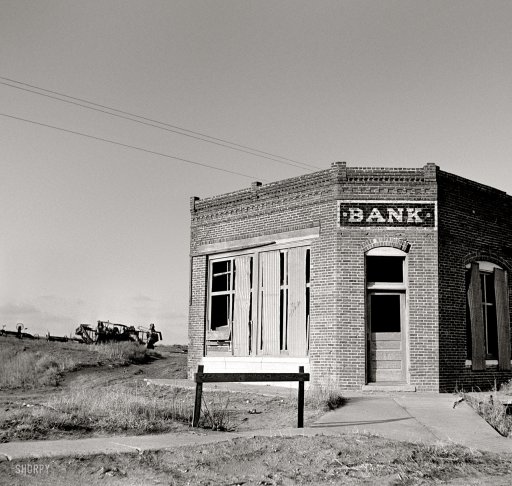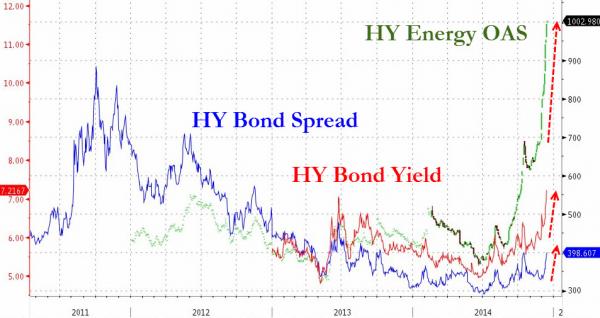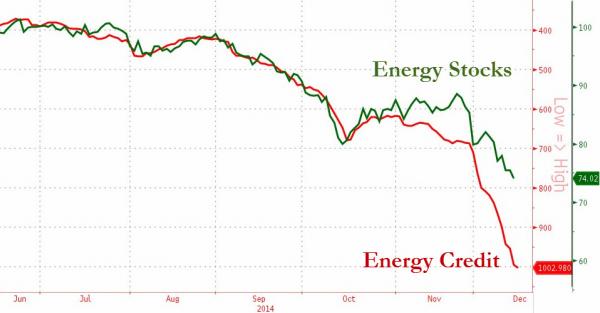
Arthur Rothstein “Bank that failed. Kansas” May 1936
Few may have noticed it to date, but it’s not like we still live in the same world, just with lower oil prices. We live in a different world altogether, with the changes between the new and old brought about by the (impending) disappearance of a lot of – virtual – money, or credit, give it a name, and the difference between oil at $110 and oil at $50.
And for the same reason Dorothy feels it necessary to point out to Toto where they find themselves, we have to tell people out there who may think they are indeed still in Kansas that no, they’re not. Or, if we play around with the metaphor a bit, they’re in Kansas, but a tornado has passed through and rendered the entire state unrecognizable.
A big problem is that for most people, Kansas is what the state tourist bureau (re: US media) says it is, all generously waving corn and sunshine, not the bleak reality they actually live in. It’s not easy to figure things out when so much rests on you being and remaining ignorant.
But whether we like it or not, and understand it or not, there’s a major reset underway as we speak. The fake impression, the false picture, of the economy, delivered by global central bank stimuli over the past years, is starting to unravel, as I talked about in Will Oil Kill The Zombies?. And the central banks are starting to figure out that doing more of the same may not work anymore to keep up keeping up appearances.
Very early today, WTI oil fell through $55, and Brent through $60. As I write this, they’re living dangerously just below the edge of $54 and $59, respectively. And again, this is not because the dollar is particularly strong; as a matter of fact, the greenback has a temporary weak spell vs the pound and the euro (1.5% in 2 weeks?!). Otherwise the damage to oil prices, counted in dollars, would be even greater, and substantially so.
When the United Arab Emirates energy minister over the weekend said OPEC won’t even cut production if prices reach $40 a barrel, he effectively set a new price (-goal). And let’s not forget that lots of oil already sells far below the WTI or Brent standards. It’s a buyers market out there, with plenty panicked producers/sellers. Because if inertia inherent in longer term delivery contracts, some of the shock will come only later, but it will come.
And oil prices will rise again at some point, but what will be left behind will resemble Kansas after a tornado. Besides, don’t expect a rebound anytime soon: I don’t believe for a moment that demand is not overreported (China,Europe, Japan, emerging markets) and production underreported (panicked producers). This baby has a ways to run yet.
But as I’ve discussed many times already, oil is just the spark that sets the world ablaze. The fuel is energy credit, junk bonds, leveraged loans, collateralized loan obligations. And it will spread to adjacent instruments, and then to just about everything, because shorts and losses will have to be covered with any asset that can be sold, loans called in, margin calls issued, etc. Many of these items will end up being valued at 20-30 cents on the dollar at best, and since the whole edifice was built on leveraged credit, those valuations will in many cases mean a death in the family.
The reason why is relatively easy to find if you just follow the – money – trail.
CNBC has an energy trader talking:
Oil Has Become The New Housing Bubble
The same thing that happened to the housing market in 2000 to 2006 has happened to the oil market from 2009 to 2014, contends well-known trader Rob Raymond of RCH Energy. And he believes that just as we witnessed the popping of the housing bubble, we are in the midst of the popping of the energy bubble. “It’s the outcome of a zero interest rate policy from the Federal Reserve. What’s happened from 2009 to 2014 is, the energy industry has outspent its cash flow by $350 billion to go drill all these wells, and create this supply ‘miracle,’ if you will, in the United States.”
“The issue with this has become, what were houses in Florida and Arizona in 2000 to 2006 became oil wells in North Dakota and Texas in 2009 to 2014, and most of that was funded in the high-yield market and by private equity.” [..] when it comes to the price of a barrel of oil itself, Raymond expects to see a rebound once U.S. production dries up. “We live in a $90 to $100 world,” he said. “We just don’t live in it today.”
Obviously, Rob Raymond expects to return to Kansas one day. The boys at Phoenix, via Tyler Durden, are not so sure, I don’t think. They make the good point that a dollar rally is oil negative, making my earlier point about the dollar’s – relative – weakness these days more poignant. “Oil is just the beginning ..”:
Oil’s Crash Is the Canary In the Coal Mine for a $9 Trillion Crisis
The Oil story is being misinterpreted by many investors. When it comes to Oil, OPEC matters, as does Oil Shale, production cuts, geopolitical risk, etc. However, the reality is that all of these are minor issues against the MAIN STORY: the $9 TRILLION US Dollar carry trade. Drilling for Oil, producing Oil, transporting Oil… all of these are extremely expensive processes. Which means… unless you have hundreds of millions (if not billions) of Dollars in cash lying around… you’re going to have to borrow money.
Borrowing US Dollars is the equivalent of shorting the US dollar. If the US Dollar rallies, then your debt becomes more and more expensive to finance on a relative basis. There is a lot of talk of the “Death of the Petrodollar,” but for now, Oil is priced in US Dollars. In this scheme, a US Dollar rally is Oil negative. Oil’s collapse is predicated by one major event: the explosion of the US Dollar carry trade. Worldwide, there is over $9 TRILLION in borrowed US Dollars that has been ploughed into risk assets.
Energy projects, particularly Oil Shale in the US, are one of the prime spots for this. But it is not the only one. Emerging markets are another. Just about everything will be hit as well. Most of the “recovery” of the last five years has been fueled by cheap borrowed Dollars. Now that the US Dollar has broken out of a multi-year range, you’re going to see more and more “risk assets” (read: projects or investments fueled by borrowed Dollars) blow up. Oil is just the beginning, not a standalone story.
If things really pick up steam, there’s over $9 TRILLION worth of potential explosions waiting in the wings. Imagine if the entire economies of both Germany and Japan exploded and you’ve got a decent idea of the size of the potential impact on the financial system. And that’s assuming NO increased leverage from derivative usage. The story here is not Oil; it’s about a massive bubble in risk assets fueled by borrowed Dollars blowing up.
The last time around it was a housing bubble. This time it’s an EVERYTHING bubble. And Oil is just the canary in the coalmine.
Yves Smith goes so far as to ponder a link to the disgraceful spending bill additions signed off on by Congress and Senate a few days ago. The first but is from Tom Adams via e-mail:
Did Wall Street Need to Win the Derivatives Budget Fight to Hedge Against Oil Plunge?
Why are the proponents pushing so hard, with respect to the Dodd-Frank provision on derivatives pushed out of insured banks, to get this done now? Why not just wait until Republicans have control of the House and Senate? Why is Jamie Dimon calling on members now, rather than just waiting? The timing is weird. Perhaps there are political reasons that give various parties cover they want and that’s all there is to it. On the other hand, I’ve been closely watching the blow up in the oil and energy markets and I wonder if there may be a link to the Cromnibus fight.
Much of the recent energy boom has been financed with junk debt and a good portion of that junk debt ended up in collateralized loan obligations. CLOs are also big users of credit default swaps, which was an important target of the Dodd Frank push-out. In addition, over the past 6 months banks were unable to unload a portion of the junk debt originated and so it remained on bank balance sheets. That debt is now substantially underwater.
To hedge, banks are using CDS. Hedge funds are actively shorting these junk debt financed energy companies using CDS (it’s unclear where the long side of those CDS have ended up – probably bank balance sheets and CLOs). Finally, junk financed energy companies have been trying to offset the falling price of oil by hedging via energy derivatives. As it turns out, energy derivatives are also part of the DF push-out battle.
Conditions in the junk and energy markets are pretty dire right now as a result of the collapse in oil, as you know. I suspect there are some very anxious bank executives looking at their balance sheets right now. Since the derivatives push-out rule of Dodd Frank was scheduled to go into affect in 2015, the potential change in managing their exposure may be causing a lot of volatility for banks now – they need to hedge in large numbers at the best rates possible.
Is it possible that bank concerns (especially Citi and JP Morgan) about the potential energy-related losses are why Dodd Frank has to be changed now?
Then Yves herself explains:
To unpack this for generalists, CLOs or collateralized loan obligations, are used to sell highly leveraged loans, which are typically created when private equity firms take companies private. In the last big takeover boom of 2006-2007, which was again led by private equity buyouts, banks were left with tons of unsold CLO inventory on their balance sheets. The games banks played to underreport losses (such as doing itty bitty trades with each other or friendly hedge funds to justify their valuations) and the magnitude of the damage didn’t get the attention they warranted because all eyes were on the bigger subprime/CDO implosion.
This CLO decay could eventually be more serious than the losses after the 2006-7 buyout boom. This time, the lending was less diversified by industry. Although it hard to get good data, by all account shale gas companies have been heavy junk bond issuers, and energy-related investments have also been disproportionately represented in recent acquisitions. The high representation of energy bonds in junk issuance means they are also the largest single industry exposure in junk bond ETFs, which were wobbly even before oil started taking its one-way wild ride.
Zero Hedge turns again to the high yield (junk bond) energy spread graph(s), and rightly so, because what’s visible here is how extreme the situation has already become. Already, because we’ve barely even left Kansas and started our adventure. There’s a long way to go yet, and there’s no way back. This will have to play out. (BTW, OAS is Option-Adjusted Spread)
Energy High-Yield Credit Spreads Blow Above 1000bps For First Time Ever
For the first time on record, HY Energy OAS has broken above 1000bps – signifying dramatic systemic business risk in that sector (despite a modest rebound today in crude prices). The energy sector is entirely frozen out of the credit markets at this point with desk chatter that there is no bid for this distressed debt at all and air-pockets appear everywhere as each new trade reprices the entire sector. The broad high-yield ‘yield’ and ‘spread’ markets are now under significant pressure – both pushing to the cycle’s worst levels. HY Energy weakness is propagating rapidly into the broad HY markets:

This suggests significant weakness to come for Energy stocks:

This cannot end well (unless the Fed decides monetizing crude in addition to TSYs and E-Minis is part of its wealth preservation, pardon “maximum employment, stable prices, and moderate long-term interest rates” mandate…)
The problem with that last bit, monetizing crude, is as I’ve said, and Zero Hedge quoted me on that a few days ago, that saving the US oil industry that way would also mean bailing out Putin and Maduro, which would seem a political no-go. There’s also the fact that the American people may not appreciate the Fed driving oil prices higher just as they get a chance to spend less on gas while they’re hurting. Another no-go.
I don’t see them do it. If they bail out anyone, it’ll be the banks again if these start bleeding too much from energy stocks, bonds, loans, derivatives and related losses. I’m thinking the oil industry will have to save itself through defaults, mergers and acquisitions. Let Shell buy BP, and let them buy up broke shale companies on the cheap and slowly kill off production. Looks like a plan. America should have gone for financial independence, not energy independence, come to think of it.
As for the American people, to play with the Kansas metaphor a little more, it’s going to feel like the Fed and the Treasury kicked them out of Kansas. Or North Dakota, if you must. And you may be thinking: who cares about living in Kansas, but it’s a metaphor. And Dorothy felt right at home, remember? It was paradise, or at least her comfort zone. In other words, the real question is how you are going to feel about being kicked out cold and hard of your comfort zone. Because that is what this low oil price ‘adventure’ will end up doing to a lot of people.
But do let’s put it in perspective: it doesn’t stand on itself, neither the oil prices nor the financial losses they will engender. We’re watching, in real time, the end of the fake reality created by the central banks.







